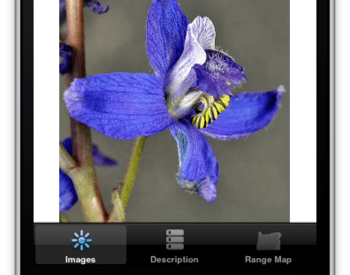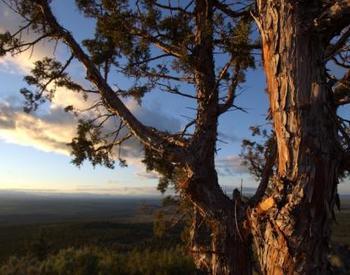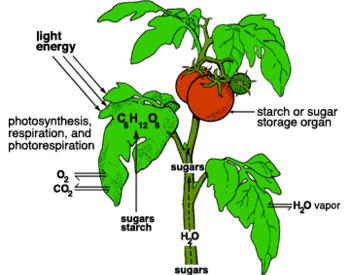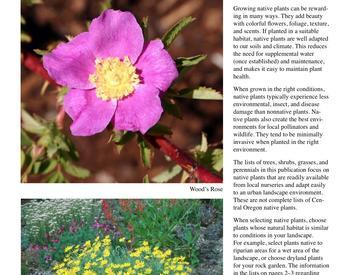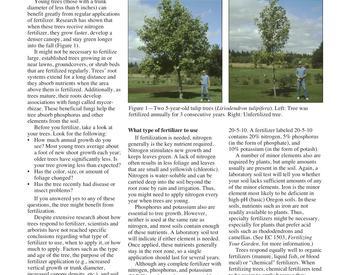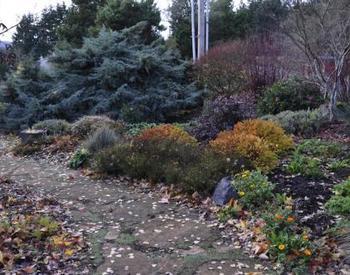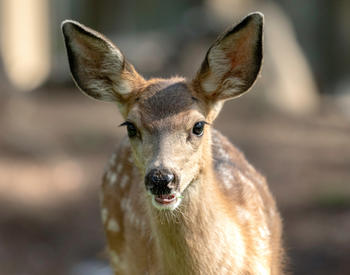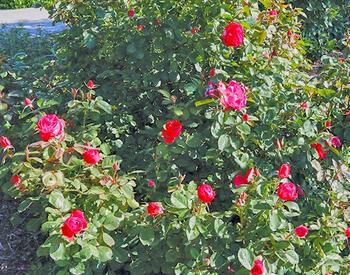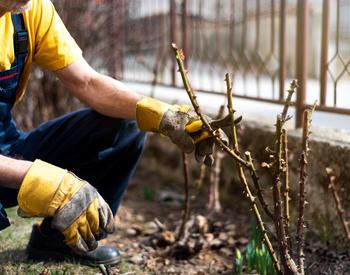Transcript
Andony Melathopoulos: [00:00:00] I love Oregon. I love it, love it, love it, love it. And one of the things I really love about this state is Oregon flora. You'll know, from a previous episode, we had the director of Oregon Flora, Linda Hardison, and she talked about the project, which is taking science-based information and putting it in your hands about the distribution of plants that are in Oregon.
It really fulfills the land-grant mission of empowering all of you to make really wonderful discoveries and take knowledge and put it to work. Now this past year, Oregon Flora has been very busy and they've got two new tools for all of you to be able to do great work with plants and pollinators.
First thing, is they got a brand new website, which we're going to talk about with Linda today. And also, they've got volume two of the flora that includes some very good pollinator plants and a chapter devoted to pollinator plant interactions. If you're not from Oregon, still a great episode to listen to, because this is the kind of program you want to develop in your state.
So without further ado, let's talk to the plant wizard, Linda Hardison, director of Oregon Flora this week on PolliNation. We're so glad, excited, thrilled to have Linda Hardison back on PolliNation. Welcome. Welcome back.
Linda Hardison: [00:01:18] Thanks. It's great to be here.
Andony Melathopoulos: [00:01:20] I'm so excited to have you back because there are two great new products from Oregon Flora that every pollinator enthusiast in Oregon is excited about.
Namely, you've got the new website. But also volume two of Oregon Flora. So before we get into that, cause that's what I want to cover in this episode. I think people want to know the details cause it's coming down the... well it's down the pipe in one case, and coming down the pipe in the other. Just remind us briefly of Oregon Flora's, mission and history.
Linda Hardison: [00:01:49] Oregon Flora is a program that's based at Oregon State University to gather and share information about the vascular plants of the state. So that's everything that includes grasses, ferns , little herbs, trees, shrubs. There are over 4,700 different plants in the state, and that takes a good organizing system to make sense of it and make that information useful.
So in doing this, we've been working at this since 1994, and one of the main organizers is creating a flora or a comprehensive reference about these plants. And that's taking shape in two formats: in a three volume set of books called The Flora of Oregon, and our website, which is a digital version of the flora.
Like you said, we've just published volume two of The Flora and those books, as well as the information found and usable on the website, includes detailed descriptions about every single one of these plants and ways to identify them through keys. And then the books also have beautiful pen and ink drawings and lots of other good stuff we can talk about.
Andony Melathopoulos: [00:03:04] Okay. Fantastic. And I think we went into it a little bit more detail in the previous episode, so we'll make sure that it's linked because it's not an easy process of taking historic records, lining them up with contemporary names, and it's just this very complex process that you guys have worked out over the last few decades. So this is really impressive. Okay. But volume two... so I heard you say it's released. The last I heard it was on its way, but one can get a physical copy now?
Linda Hardison: [00:03:34] Mostly. It's been such a great year, right? Anyway, that's created a few delays in the shipping, but volume two is published; it is printed.
Andony Melathopoulos: [00:03:46] There it is. I can see it. Oh, it's so beautiful.
Linda Hardison: [00:03:50] Well, it's on its way to our publisher's house in Texas, and they anticipated arriving and being able to fill orders the first week of January. So that's just two weeks away.
Andony Melathopoulos: [00:04:02] I'm so excited. I'm really looking forward to getting a copy. And I know for a number of reasons, can you tell us why this volume is of particular interest to pollinator enthusiasts?
Linda Hardison: [00:04:15] This volume , like all of our volumes, have, and will have, introductory chapters that go into details about plants and ways that plants relate to things. And what's super exciting for your audience is that we have a very big chapter on plant-insect interactions. It focuses on pollinators and butterflies, and there are caterpillars and the food plants that both of these use and interact with. And it also has amazing appendices with all of the nuts and bolts and details in the back that are pretty comprehensive.
Andony Melathopoulos: [00:04:54] It's really remarkable. I've had a chance to take a look at it. You know, you always hear about like, "Oh, here are the plants and here are the pollinators and here are the connections..."
But , Andy Moldenke contributed for example, to the bee section. And it, you know, Andy hasn't written a lot of stuff. Like he's done pieces, but here is kind of like years of his thought on studying the interconnection between bees and the plants kind of condensed into that chapter.
Linda Hardison: [00:05:24] It's really amazing. So you mentioned Andy Moldenke.
Andy is one of the authors, the other two co-ops there's are Jeffrey Miller, who's a butterfly and moth expert, and Dennis Albert, who's an ecologist. And it really is, I think in one place, information that is this brain trust of these guys and the decades that they have of boots on the ground knowledge.
And so it's a phenomenal resource and the color photographs are just stunning too. There are like 66 color photographs illustrating these concepts and examples throughout the chapter.
Andony Melathopoulos: [00:06:05] Well, I remember in volume one how rich the introduction was. If anybody wants an idea of biogeography in Oregon, it really is a must-read.
It's so well thought out, and again , in that case really drawing together years of knowledge about the eco regions of Oregon. Really wonderful.
Linda Hardison: [00:06:26] One thing in keeping aligned with that work that we did in, in volume one, as well as sort of the whole lens through which Oregon Flora views our data is through an eco region lens.
You know, how does plant fit into the landscape? Because that's a lot more meaningful than just giving you a laundry list of species names. And so we've applied that concept to this insect interactions chapter, and it's arranged by what we call physionomic regions or physionomics areas.
And so you can get to a section about prairies and moist meadows, and then we break it down and talk about the kinds of different plant families and what insects you might see on these plant families, and give little stories and examples about this. So it's really designed, we designed the chapters so that people could use this almost as a guide to their explorations outside.
If you go to alpine areas, you can read that section and discover some of the insect-plant interactions you might encounter at that place.
Andony Melathopoulos: [00:07:32] I'm always ... we were talking about this before we started the interview: I'm always so grateful for the Oregon Bee Atlas. We rely so much on Oregon Flora's data to direct our volunteers to go find bees.
It's just having that as the foundation for our work is... we're so fortunate. Not a lot of states have nearly that level of detail on the plant communities.
Linda Hardison: [00:07:55] Thank you. We have been gathering information and that's the huge body of information that Oregon Flora has and can use the digital format of our website to share, but where we get all this information. You know, you talked about where we're plants occur... and we have now on our mapping tool on our new website over 1.2 million records of places where plants have occurred, and this is through time. And so we have records dating from the late 18 hundreds up to a couple of weeks ago that come from either information on herbarium specimens, they come from observations that people have made, and this can be all different levels of people, whether it's a government agency or a researcher, or an informal learner, like the native plant society members. And also, of photographs that have a location associated with them. So we have this huge body of information about where plants have occurred everywhere across the state and through time.
Andony Melathopoulos: [00:09:07] It is remarkable. And I guess one of the things I loved about volume one is I could open up to page, find the plant, and then see a range map. Like I had a description of where this plant is expected to occur and that's just so useful for somebody who's trying to use the plant to look for pollinators.
Linda Hardison: [00:09:26] Yes. And that is a really nice feature of the books, that every single plant has a little map that shows you dots of where we have those Oregon State University herbarium specimens. So those are verified, vouchered plant occurrences through time, and it's a great way to get a gestalt for where a plant occurs and to compare against different species.
Andony Melathopoulos: [00:09:54] The one thing we haven't mentioned is what is in volume two. What plant families are covered?
Linda Hardison: [00:10:02] Volume two covers the first families of the dicot. So those are things, you know, if you remember back to your basic botany , that have two little seed leaves and a lot of the broad leafs, forbs, and herbs.
And so we do them alphabetically by family. So it's families aizoacea through fagaceae. So what does that mean? It's 1,668 different species or subspecies of varieties and the big plant families in this one, there's some pretty heavy hitters. There is the sunflower family. There is the mustard family, or brascaceae.
The legumes, the fababeae, and the oaks, fagaceae, the carrot family or parsley family apiacae. So all of those, especially the comps, the, the apiacae, those I think are pretty important to pollinators.
Andony Melathopoulos: [00:10:57] Okay. Absolutely. They are right on the front cover; it looks like you have a Balsam root.
Oh, and you have a print of the front cover on your wall. That's awesome.
Linda Hardison: [00:11:08] We are so lucky to have the beautiful artwork of the late Bonnie Hall to grace our volume covers. And she was a very big supporter and her husband has generously allowed us to use her prints for the books.
And it really is special. They're, they're lovely.
Andony Melathopoulos: [00:11:26] They are; they're so wonderful. Well, let's take a quick break and then let's dive back in and talk about the website.
Linda Hardison: [00:11:32] Sounds good.
Andony Melathopoulos: [00:11:38] Okay, we're back. So tell us about the brand new website. It looks super slick and it has all sorts of new features.
Tell us about some of the new features and you were describing before... there's also just a whole lot more records and ways to search for plants in the state.
Linda Hardison: [00:11:56] Right. This has been a long time in the making and , it's been a long and winding road. We are so happy. This late October, we released to the public, our redesigned website, which is Oregon flora.org.
And you're right: it does have a ton of stuff in it that makes it really easy for people of all different expertise and knowledge bases to find information about plants. And that's been different. We worked really hard to make it much more accessible to a broad audience. When you go to the site, you'll see that there are different tools that we have, and I'll just talk about a few of them .
Across our tab at the top, we've got the tools as well as some little thumbnails on the homepage. You can map plants. And one thing that's different that this website lets you do now is you can draw your own shape from a place you're going. Say you're going to go on a hike and you want to know what sort of plants to expect there.
You can go to the map. And draw a shape around that. And then you'll get back a list of all the different records of plants that have been known to occur in that area. You can also say: "where can I find all the vine Maples in Oregon in adjacent States?" And you can, can use the mapping program that way too.
Another great tool is the identify plants tool. And this is I think the magic door that opens botany and plant information to the world. Because you start by... it's a map of the state, and you typically have an idea of where you are when you're out somewhere, trying to identify some plant you've never seen and you don't know what it is. So you just drop a pin, click on the spot on the map, and then the tool opens up a list of things that we have seen in that area. And it gives you options that you can filter on for characters that you recognize. It might be whether the leaves are opposite each other, or they're in a whirl on the ground. It might be what kind of habitat it's in; is it in a wetland? Is it on a rocky outcrop? What color the flowers are? And as you choose each one of these, the list gets smaller and smaller until you can identify and compare it to your unknown.
Throughout the website, almost every instance of a scientific name, is a link to a profile page about it. So at any time, pretty much any place on the website, you can click on a plant name and then pull up a page that gives you photographs, that distribution map, a little dot map with where things are, is it a native plant? Is it an introduced? Common names?
When it's available, a description, a detailed description of the plant, and external links, as well as access to all of these photographs. It's just a phenomenal tool.
Andony Melathopoulos: [00:15:08] I got distracted as you were talking cause I was just you know looking up some phacelia in Burns, and there is. It has this wonderful description, so easy to find, and it just gave me this huge map where I could just drill down and find stuff.
But I also liked that it has the same features as the... I mean, I really love the Oregon Flora app on my phone; it's really reliable. But it has all the features of the Flora app as well with the kind of like "I'm in this area," which was always the great thing about the Oregon Flora app is you could be in mid-Columbia and you could say "I'm in mid-Columbia, it's got a yellow flower it's got..." and then suddenly you're down the street and it's May. It's like "oh, well that's easy."
Linda Hardison: [00:15:56] Right? Exactly. And that's the beauty, but you know, now we're doing this for the entire flora, you know, all 4,700 something plants. And it gets you so much closer than facing dichotomous keys in black and white ink on pages that have 16 pages of choices to make, with complicated vocabulary. And in no way do I mean to diminish the value of a flora and those kinds of keys, because those are critical when you want to get down to it and discern between very subtle differences.
You must have something as precise as the flora, but this gets you super close, super fast. And the website again, you know, I keep pounding on it. It's a way that everybody can find out something about plants and spark their curiosity, and satisfy their curiosity.
Andony Melathopoulos: [00:16:52] Another feature of the website that I really like is : you talked about this the last time you were in development, but you have the capacity now, if you're a gardening, to be able to find the native plants. Tell us a little bit about that feature.
Linda Hardison: [00:17:06] Oh, boy, that has been so fun. So, a major tool that Oregon Flora produced is the grow natives section of our website. And this was done to share information about native plant species that are appropriate or useful for gardening and landscaping. We currently have just over 200 different plants that fit this criteria, and the ones that you see on the website, these 200 something plants have or are commercially available.
So that's really important. And it functions, when you go to the site, you can either get some preform suggestions about plant combinations or plant pallets that would fit into a particular landscape such as a rock garden, or a rain and water garden. Or you can just look at the beautiful pictures and then select from characters, just like I was describing on the identified plants.
You can choose from characters that are going to help you meet your garden or landscape objective. Like "I want something that will work in a well-drained area." So you can select that. And again, the list winnows and you see your options.
Andony Melathopoulos: [00:18:24] Goodness, I'm just doing this. So there's a pollinator garden option, and I'm just going through and I'm like, "I am in the Willamette Valley, and ease of growth: well, it's me, so it's gotta be easy." And now I've got I've got a reduced list now. I've got: here's the easy plants of the Willamette Valley. Awesome.
Linda Hardison: [00:18:47] Yes. It's really great. And we are expanding this. A lot of these are focused on Willamette Valley Cascade taxa, and we're expanding it over the next year to include a third more , a hundred more different plants, that that thrive on the East side. So again, this is a tool for everybody in the state and the area.
Andony Melathopoulos: [00:19:08] Gosh, this is amazing. It is so slick. It's you know, when you were talking to me about this a couple of years ago, I didn't quite realize how slick this was going to be. This is so amazing. Wow. Yeah. It almost puts the, you know, what's the California thing...
Linda Hardison: [00:19:27] Calflora.
Andony Melathopoulos: [00:19:29] It's like, it's a little, this is so easy and fast.
Just that process of going through the pollinator garden and making those selections. It, it was snap quick. Like everything just updated a really fast. Amazing job. Now, all of this stuff, I think people may not realize it's not that Oregon Flora is a funded program at OSU. All the money has to be raised.
Tell us a little bit about that and how people can donate to Oregon Flora and how people can get volume two in their hands.
Linda Hardison: [00:20:02] Sure. As you said, our program, right from the get go has been externally funded. And so what that means is that all of our salaries, our staff health insurance, our computers, our server hosting, all of that comes from money that we raised through competitive grants, or gifts, or donations. And It's something that the whole program is something that I like to think is easy for people to help support when they realize how useful it is and that we're offering this up for use by anybody.
And so if it's useful for you, we really hope that you'll contribute so that we can keep maintaining and developing this, because not only does funding help us make it even better, but it helps us keep it up-to-date, which is really essential for making it a useful tool. You can't work with out-of-date information, and this this knowledge and this information takes some diligence to reflect the latest scientific research.
The best way to donate is simply to go to our website and on the tab, there is a contribute button that you can do. And there is a big donate button; there are donate buttons scattered throughout.
Andony Melathopoulos: [00:21:28] That's right. Keep going. Yeah.
Linda Hardison: [00:21:32] Yeah. I wanted to tell you about the Flora of Oregon volume two. And where you can access that.
Like I said, it's making its way hopefully in trucks or airplanes to our publisher, and we'll be ready for distribution in a couple of weeks. And what's easiest and, best for us is if you order directly from the publisher. And you can do that on the website, under that contribute tab, by going to the Oregon Flora store.
And I'll just put in a pitch as probably many of us have been aware of this year, especially these small businesses and individuals that really need the support of their community , benefit when you order directly and work directly through the small businesses. And our publisher Botanical Research Institute of Texas is a small publisher that focuses on botanical works.
And so ordering directly from them helps both that press stay functioning, and it also helps direct a little bit more of the royalties to our program.
Andony Melathopoulos: [00:22:43] And it's so easy. You just go... I did it in three clicks. I went up to the contribute button and then Oregon Flora store. And then purchase volume two and there I am. So easy. I love this website. Everything's easy.
Well, thank you so much. I imagine, as soon as volume two's done volume three starts and I imagine...
Linda Hardison: [00:23:13] We've been working on volume three, believe me. Actually, the good news is that we're over half way with the plan details for volume three, and we're working on two, also exciting chapters, front chapters, one about ethnobotany and one about climate change.
So these are great books. And, just as you know, since I didn't mention it. One of the other chapters, front chapters, in this volume two goes hand in hand with the insect-plant interactions, and it's about landscaping with native species.
Andony Melathopoulos: [00:23:49] Really.
Linda Hardison: [00:23:50] Yes. And it too, has an appendix information that lists over 300 plants with some basic characters that are relevant to gardeners.
So that's yet another reason to get volume two on your shelf.
Andony Melathopoulos: [00:24:04] Fantastic. Well, that is so great. Congratulations. You've managed to turn 2020... it's become just a little bit brighter from all of everything that happened. So keep up the great work at Oregon Flora, and I look forward to catching up with you again when volume three comes out.
Linda Hardison: [00:24:21] Thanks so much in Andony.
There have been two exciting developments with Oregon Flora. The first is vol 2 of the flora, which includes an amazing section on Oregon pollinators. The second is their new website, which allows you to do amazing searches for Oregon plant communities.
Linda Hardison is the director of the Oregon Flora and a research assistant professor in the Botany & Plant Pathology Dept. at Oregon State University. She grew up in Texas, and received undergraduate degrees in botany and marine biology at the University of Texas at Austin. She moved to the Pacific Northwest to attend graduate school at the University of Washington, and received her Ph.D. in botany there in 1995. In 1996 Linda made Corvallis her home and began a post-doctoral position in the Botany Dept. at OSU. Linda has been director of the Oregon Flora since 2005.
Links Mentioned:
The new awesome Oregon Flora website





